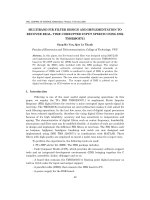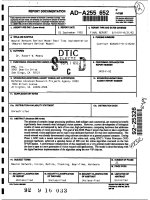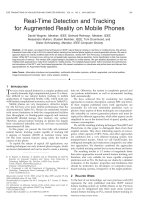AN1303 software real time clock and calendar using PIC16F1827
Bạn đang xem bản rút gọn của tài liệu. Xem và tải ngay bản đầy đủ của tài liệu tại đây (69.09 KB, 6 trang )
AN1303
Software Real-Time Clock and Calendar Using PIC16F1827
Author:
Cristian Toma
Microchip Technology Inc.
INTRODUCTION
This application note describes the implementation of
software Real-Time Clock and Calendar (RTCC). The
implementation can be used either separately,
replacing one of the hardware RTCC devices on the
market, or as part of an application. In the latter
example, there is no need for the I2C™ communication
channel.
The implementation provides the time (seconds,
minutes, and hour), date (day, month, and year), day of
week, and one alarm. The user can customize the
firmware according to his/her own needs.
DATA INTERFACE
The Real-Time Clock and Calendar communicates with
the host system via a two-wire I2C bus as a slave
device. A set of I2C commands and RTCC registers are
implemented to allow the host to read and write time
and date information. All registers are read and write.
The registers from 0x00 to 0x0E only support one byte
read/write operation (for compatibility with hardware
RTCCs already on the market). The registers from
0x0F and 0x10 support multiple byte read/write
operation. This is to allow multiple data to be sent in
one single transfer. Of course, the user has the ability
the change the source code, thus changing the
functionality to suit his/her own needs.
TABLE 1:
INTERNAL REGISTER MAP
Timer1 can operate during Sleep mode to help reduce
the current consumption of the application. A Timer1
roll-over event (TMR1IF bit) will wake the
microcontroller from Sleep and execute the next
instructions. It should be noted that, upon an overflow,
the TMR1IF flag is set, but the counter continues to run.
Time and date update can be done at a later time,
provided that another Timer1 roll-over does not occur.
2009 Microchip Technology Inc.
0x03
0x04
0x05
0x06
0x07
0x08
0x09
0x0A
0x0B
0x0C
0x0D
0x0E
Alarm Date/Time
0x01
0x02
Current/Date/Time
The basis of the Real-Time Clock (RTC) is the Timer1
counter. This timer can be configured to accept a clock
source from the internal low-power oscillator. This
internal circuit is used in conjunction with an external
32.768 kHz crystal. The oscillator has the ability to work
during Sleep mode. This feature can be very helpful if
the Real-Time Clock and Calendar circuit is to be
powered from a battery. The Timer1 register pair
(TMR1H:TMR1L) counts from 0x0000 to 0xFFFF. If the
register is incremented from 0xFFFF, then a roll-over
event occurs and the timer rolls over to 0x0000.
Additionally, the interrupt flag, TMR1IF, is set and an
interrupt will occur if enabled. The flag must be cleared
in the software.
Description
Current Date/Time
Hex address
IMPLEMENTATION
Time
Date
Time
Date
Time
Date
Range
Seconds
00-59
Minutes
00-59
Hour
0-23
Day
0-6
Date
1-31
Month
1-12
Year
Minutes
0-99
00-59
Hour
0-23
Date
1-31
Month
1-12
Year
0-99
Seconds
Minutes
Hour
00-59
00-59
0-23
Date
Month
Year
1-31
1-12
0-99
DS01303A-page 1
AN1303
DAY OF WEEK CALCULATION
The algorithm must calculate the day of week (e.g.,
“Monday”, “Tuesday”...), based on a given date (e.g.,
1st January 2000). There are several algorithms that
provide this calculation, but one we have chosen is fast
and the code implementation is small.
There are several considerations that can make the
algorithm easier to implement. We do not need to store
the “year” information using the full 4 digits (e.g.,
“2005”), but only the last two digits. The “year 2000
problem” is now history and, anyway, we are more
interested in dates starting from present time to
ten-to-twenty years from now.
4.
Day of month: We now know on which day of the
week the month starts. We must simply add the
day of the month to get the day of week.
After we have all the four numbers, we simply add them
and use modulus of 7 to limit the values between zero
and six. The corresponding day of the week is given in
the following table:
TABLE 3:
CORRESPONDING DAY OF
WEEK
Value
Corresponding day of week
0
"Sunday"
The day-of-week algorithm must calculate four
numbers:
1
"Monday"
2
"Tuesday"
1.
3
"Wednesday"
4
"Thursday"
5
"Friday"
6
"Saturday"
2.
Centuries: There is a table for centuries. But as
we previously mentioned, we are interested only
in the current century. So, the value for the years
2000-2099 is 6. The centuries number will
always be 6.
Years: There are 365 days in one year. Each
leap year has one more day than a normal year.
If we add the number of years elapsed from the
start of the century with the number of the leap
years elapsed from the start of the century, we
get the day of the week when the year starts.
Here we take into account only the last two digits
of the year.
y = year + year
----------4
Months: we must use the months table to get the
day of the week a month starts on. Every January starts on the first day of each year. Please
notice that the table has corrections for the leap
year.
TABLE 2:
Let’s use Thursday, the 1st of October, 2009:
1.
2.
3.
4.
5.
EQUATION 1:
3.
Here is an example:
6.
7.
We are interested in this century only. The first
number is 6.
Note the last two digits of the year: 09.
Divide 09 by 4, leave out the remainder. 9/4 = 2.
Look at the month table: for October, we have a
value of 0.
Add all the numbers we have until now with the
day the month. 6 + 9 + 2 + 0 + 1= 18
Divide 18 by 7 and find the remainder: 18/7= 2
remainder 4.
Use the corresponding day of week table
(Table 3). For value 4, we get the day of
Thursday.
MONTHS
January 0 (in leap year 6)
February 3 (in leap year 2)
March 3
April 6
May 1
June 4
July 6
August 2
September 5
October 0
November 3
December 5
DS01303A-page 2
2009 Microchip Technology Inc.
AN1303
LOW-POWER
CONCLUSION
A Real-Time Clock can be powered by an alternate
backup power supply, such as a coin cell battery.
Typically, while the main system is running, there will be
power from the main power supply. While the main
system is turned off, there cannot be any read/write
request from the host, thus the Real-Time Clock circuit
will typically draw power only to update the time and the
date.
This application note shows the ease of implementing
a software Real-Time Clock and Calendar using the
PIC16F1827.
The
Extreme-Low-Power
(XLP)
technology features make this design a well-suited
solution in terms of overall cost, performance and
power consumption.
In order to preserve energy, the processor must stay in
Sleep mode as much as possible. The internal
low-power oscillator will continue to work during Sleep
mode. The Timer1 counter is configured to wake the
processor from Sleep once every second. The time is
updated (also the calendar, if needed) and the
processor goes back to Sleep mode. The same applies
for accessing the internal registers via the I2C bus. The
processor wakes up from Sleep following a Start
condition and goes back to Sleep mode after a Stop
condition.
CODE RESOURCE REQUIREMENTS:
• Flash program memory – 821 words (including
I2C communication with multi-byte reads and
alarm implementation)
• Data RAM size: 53 bytes
• Interrupts: Timer1 interrupt
• Timers: Timer1
• Hardware resources: External 32.768 kHz crystal
The user must make sure that all the unnecessary
modules are turned off or disabled during Sleep mode.
Also, all external power consuming parts must be
turned off.
POSSIBLE UPGRADES
The current implementation updates the time and
calendar once every second. In the previous chapter,
we learned that, in order to preserve more power, the
processor must stay in Sleep mode as much as
possible. Thus, the time spent in Active mode, when
the power consumption is higher, must be kept as short
as possible. One possible upgrade would be to have a
32-bit register incremented once every second. This
will help minimize the on-time of the microcontroller
even more. The only task the processor will do during
the active period would be to increment the counter.
The actual conversion between the counter and the
date and time will be made on demand, during an I2C
data transfer. Wake-up alarms or time-triggered events
can also be implemented using this 32-bit time-stamp
method.
2009 Microchip Technology Inc.
DS01303A-page 3
AN1303
NOTES:
DS01303A-page 4
2009 Microchip Technology Inc.
Note the following details of the code protection feature on Microchip devices:
•
Microchip products meet the specification contained in their particular Microchip Data Sheet.
•
Microchip believes that its family of products is one of the most secure families of its kind on the market today, when used in the
intended manner and under normal conditions.
•
There are dishonest and possibly illegal methods used to breach the code protection feature. All of these methods, to our
knowledge, require using the Microchip products in a manner outside the operating specifications contained in Microchip’s Data
Sheets. Most likely, the person doing so is engaged in theft of intellectual property.
•
Microchip is willing to work with the customer who is concerned about the integrity of their code.
•
Neither Microchip nor any other semiconductor manufacturer can guarantee the security of their code. Code protection does not
mean that we are guaranteeing the product as “unbreakable.”
Code protection is constantly evolving. We at Microchip are committed to continuously improving the code protection features of our
products. Attempts to break Microchip’s code protection feature may be a violation of the Digital Millennium Copyright Act. If such acts
allow unauthorized access to your software or other copyrighted work, you may have a right to sue for relief under that Act.
Information contained in this publication regarding device
applications and the like is provided only for your convenience
and may be superseded by updates. It is your responsibility to
ensure that your application meets with your specifications.
MICROCHIP MAKES NO REPRESENTATIONS OR
WARRANTIES OF ANY KIND WHETHER EXPRESS OR
IMPLIED, WRITTEN OR ORAL, STATUTORY OR
OTHERWISE, RELATED TO THE INFORMATION,
INCLUDING BUT NOT LIMITED TO ITS CONDITION,
QUALITY, PERFORMANCE, MERCHANTABILITY OR
FITNESS FOR PURPOSE. Microchip disclaims all liability
arising from this information and its use. Use of Microchip
devices in life support and/or safety applications is entirely at
the buyer’s risk, and the buyer agrees to defend, indemnify and
hold harmless Microchip from any and all damages, claims,
suits, or expenses resulting from such use. No licenses are
conveyed, implicitly or otherwise, under any Microchip
intellectual property rights.
Trademarks
The Microchip name and logo, the Microchip logo, dsPIC,
KEELOQ, KEELOQ logo, MPLAB, PIC, PICmicro, PICSTART,
rfPIC and UNI/O are registered trademarks of Microchip
Technology Incorporated in the U.S.A. and other countries.
FilterLab, Hampshire, HI-TECH C, Linear Active Thermistor,
MXDEV, MXLAB, SEEVAL and The Embedded Control
Solutions Company are registered trademarks of Microchip
Technology Incorporated in the U.S.A.
Analog-for-the-Digital Age, Application Maestro, CodeGuard,
dsPICDEM, dsPICDEM.net, dsPICworks, dsSPEAK, ECAN,
ECONOMONITOR, FanSense, HI-TIDE, In-Circuit Serial
Programming, ICSP, Mindi, MiWi, MPASM, MPLAB Certified
logo, MPLIB, MPLINK, mTouch, Octopus, Omniscient Code
Generation, PICC, PICC-18, PICDEM, PICDEM.net, PICkit,
PICtail, PIC32 logo, REAL ICE, rfLAB, Select Mode, Total
Endurance, TSHARC, UniWinDriver, WiperLock and ZENA
are trademarks of Microchip Technology Incorporated in the
U.S.A. and other countries.
SQTP is a service mark of Microchip Technology Incorporated
in the U.S.A.
All other trademarks mentioned herein are property of their
respective companies.
© 2009, Microchip Technology Incorporated, Printed in the
U.S.A., All Rights Reserved.
Printed on recycled paper.
Microchip received ISO/TS-16949:2002 certification for its worldwide
headquarters, design and wafer fabrication facilities in Chandler and
Tempe, Arizona; Gresham, Oregon and design centers in California
and India. The Company’s quality system processes and procedures
are for its PIC® MCUs and dsPIC® DSCs, KEELOQ® code hopping
devices, Serial EEPROMs, microperipherals, nonvolatile memory and
analog products. In addition, Microchip’s quality system for the design
and manufacture of development systems is ISO 9001:2000 certified.
DS01303A-page 5
2009 Microchip Technology Inc.
WORLDWIDE SALES AND SERVICE
AMERICAS
ASIA/PACIFIC
ASIA/PACIFIC
EUROPE
Corporate Office
2355 West Chandler Blvd.
Chandler, AZ 85224-6199
Tel: 480-792-7200
Fax: 480-792-7277
Technical Support:
Web Address:
www.microchip.com
Asia Pacific Office
Suites 3707-14, 37th Floor
Tower 6, The Gateway
Harbour City, Kowloon
Hong Kong
Tel: 852-2401-1200
Fax: 852-2401-3431
India - Bangalore
Tel: 91-80-3090-4444
Fax: 91-80-3090-4080
India - New Delhi
Tel: 91-11-4160-8631
Fax: 91-11-4160-8632
Austria - Wels
Tel: 43-7242-2244-39
Fax: 43-7242-2244-393
Denmark - Copenhagen
Tel: 45-4450-2828
Fax: 45-4485-2829
India - Pune
Tel: 91-20-2566-1512
Fax: 91-20-2566-1513
France - Paris
Tel: 33-1-69-53-63-20
Fax: 33-1-69-30-90-79
Japan - Yokohama
Tel: 81-45-471- 6166
Fax: 81-45-471-6122
Germany - Munich
Tel: 49-89-627-144-0
Fax: 49-89-627-144-44
Atlanta
Duluth, GA
Tel: 678-957-9614
Fax: 678-957-1455
Boston
Westborough, MA
Tel: 774-760-0087
Fax: 774-760-0088
Chicago
Itasca, IL
Tel: 630-285-0071
Fax: 630-285-0075
Cleveland
Independence, OH
Tel: 216-447-0464
Fax: 216-447-0643
Dallas
Addison, TX
Tel: 972-818-7423
Fax: 972-818-2924
Detroit
Farmington Hills, MI
Tel: 248-538-2250
Fax: 248-538-2260
Kokomo
Kokomo, IN
Tel: 765-864-8360
Fax: 765-864-8387
Los Angeles
Mission Viejo, CA
Tel: 949-462-9523
Fax: 949-462-9608
Santa Clara
Santa Clara, CA
Tel: 408-961-6444
Fax: 408-961-6445
Toronto
Mississauga, Ontario,
Canada
Tel: 905-673-0699
Fax: 905-673-6509
Australia - Sydney
Tel: 61-2-9868-6733
Fax: 61-2-9868-6755
China - Beijing
Tel: 86-10-8528-2100
Fax: 86-10-8528-2104
China - Chengdu
Tel: 86-28-8665-5511
Fax: 86-28-8665-7889
Korea - Daegu
Tel: 82-53-744-4301
Fax: 82-53-744-4302
China - Hong Kong SAR
Tel: 852-2401-1200
Fax: 852-2401-3431
Korea - Seoul
Tel: 82-2-554-7200
Fax: 82-2-558-5932 or
82-2-558-5934
China - Nanjing
Tel: 86-25-8473-2460
Fax: 86-25-8473-2470
Malaysia - Kuala Lumpur
Tel: 60-3-6201-9857
Fax: 60-3-6201-9859
China - Qingdao
Tel: 86-532-8502-7355
Fax: 86-532-8502-7205
Malaysia - Penang
Tel: 60-4-227-8870
Fax: 60-4-227-4068
China - Shanghai
Tel: 86-21-5407-5533
Fax: 86-21-5407-5066
Philippines - Manila
Tel: 63-2-634-9065
Fax: 63-2-634-9069
China - Shenyang
Tel: 86-24-2334-2829
Fax: 86-24-2334-2393
Singapore
Tel: 65-6334-8870
Fax: 65-6334-8850
China - Shenzhen
Tel: 86-755-8203-2660
Fax: 86-755-8203-1760
Taiwan - Hsin Chu
Tel: 886-3-6578-300
Fax: 886-3-6578-370
China - Wuhan
Tel: 86-27-5980-5300
Fax: 86-27-5980-5118
Taiwan - Kaohsiung
Tel: 886-7-536-4818
Fax: 886-7-536-4803
China - Xiamen
Tel: 86-592-2388138
Fax: 86-592-2388130
Taiwan - Taipei
Tel: 886-2-2500-6610
Fax: 886-2-2508-0102
China - Xian
Tel: 86-29-8833-7252
Fax: 86-29-8833-7256
Thailand - Bangkok
Tel: 66-2-694-1351
Fax: 66-2-694-1350
Italy - Milan
Tel: 39-0331-742611
Fax: 39-0331-466781
Netherlands - Drunen
Tel: 31-416-690399
Fax: 31-416-690340
Spain - Madrid
Tel: 34-91-708-08-90
Fax: 34-91-708-08-91
UK - Wokingham
Tel: 44-118-921-5869
Fax: 44-118-921-5820
China - Zhuhai
Tel: 86-756-3210040
Fax: 86-756-3210049
03/26/09
DS01303A-page 6
2009 Microchip Technology Inc.









